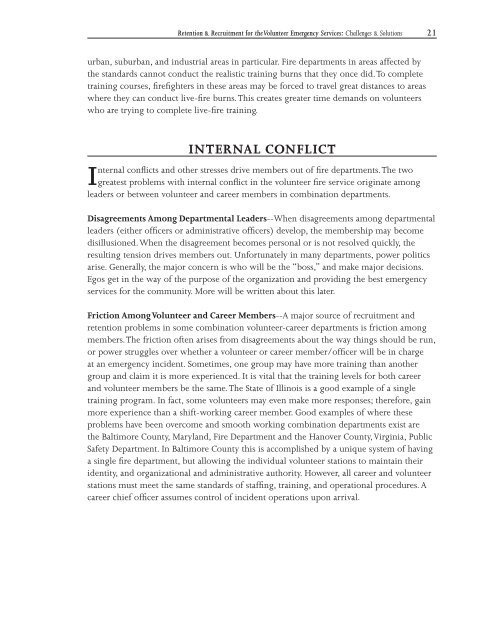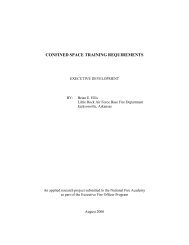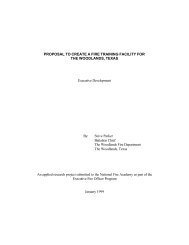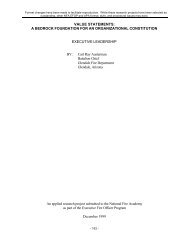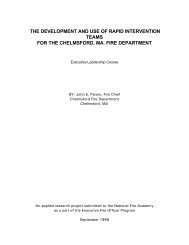Retention and Recruitment for the Volunteer Emergency Services
Retention and Recruitment for the Volunteer Emergency Services
Retention and Recruitment for the Volunteer Emergency Services
You also want an ePaper? Increase the reach of your titles
YUMPU automatically turns print PDFs into web optimized ePapers that Google loves.
<strong>Retention</strong> & <strong>Recruitment</strong> <strong>for</strong> <strong>the</strong> <strong>Volunteer</strong> <strong>Emergency</strong> <strong>Services</strong>: Challenges & Solutions<br />
urban, suburban, <strong>and</strong> industrial areas in particular. Fire departments in areas affected by<br />
<strong>the</strong> st<strong>and</strong>ards cannot conduct <strong>the</strong> realistic training burns that <strong>the</strong>y once did. To complete<br />
training courses, firefighters in <strong>the</strong>se areas may be <strong>for</strong>ced to travel great distances to areas<br />
where <strong>the</strong>y can conduct live-fire burns. This creates greater time dem<strong>and</strong>s on volunteers<br />
who are trying to complete live-fire training.<br />
internal conflict<br />
Internal conflicts <strong>and</strong> o<strong>the</strong>r stresses drive members out of fire departments. The two<br />
greatest problems with internal conflict in <strong>the</strong> volunteer fire service originate among<br />
leaders or between volunteer <strong>and</strong> career members in combination departments.<br />
disagreements among departmental leaders--When disagreements among departmental<br />
leaders (ei<strong>the</strong>r officers or administrative officers) develop, <strong>the</strong> membership may become<br />
disillusioned. When <strong>the</strong> disagreement becomes personal or is not resolved quickly, <strong>the</strong><br />
resulting tension drives members out. Un<strong>for</strong>tunately in many departments, power politics<br />
arise. Generally, <strong>the</strong> major concern is who will be <strong>the</strong> “boss,” <strong>and</strong> make major decisions.<br />
Egos get in <strong>the</strong> way of <strong>the</strong> purpose of <strong>the</strong> organization <strong>and</strong> providing <strong>the</strong> best emergency<br />
services <strong>for</strong> <strong>the</strong> community. More will be written about this later.<br />
friction among <strong>Volunteer</strong> <strong>and</strong> career members--A major source of recruitment <strong>and</strong><br />
retention problems in some combination volunteer-career departments is friction among<br />
members. The friction often arises from disagreements about <strong>the</strong> way things should be run,<br />
or power struggles over whe<strong>the</strong>r a volunteer or career member/officer will be in charge<br />
at an emergency incident. Sometimes, one group may have more training than ano<strong>the</strong>r<br />
group <strong>and</strong> claim it is more experienced. It is vital that <strong>the</strong> training levels <strong>for</strong> both career<br />
<strong>and</strong> volunteer members be <strong>the</strong> same. The State of Illinois is a good example of a single<br />
training program. In fact, some volunteers may even make more responses; <strong>the</strong>re<strong>for</strong>e, gain<br />
more experience than a shift-working career member. Good examples of where <strong>the</strong>se<br />
problems have been overcome <strong>and</strong> smooth working combination departments exist are<br />
<strong>the</strong> Baltimore County, Maryl<strong>and</strong>, Fire Department <strong>and</strong> <strong>the</strong> Hanover County, Virginia, Public<br />
Safety Department. In Baltimore County this is accomplished by a unique system of having<br />
a single fire department, but allowing <strong>the</strong> individual volunteer stations to maintain <strong>the</strong>ir<br />
identity, <strong>and</strong> organizational <strong>and</strong> administrative authority. However, all career <strong>and</strong> volunteer<br />
stations must meet <strong>the</strong> same st<strong>and</strong>ards of staffing, training, <strong>and</strong> operational procedures. A<br />
career chief officer assumes control of incident operations upon arrival.


